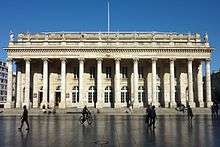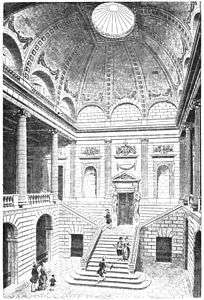Grand Théâtre de Bordeaux

Grand Théâtre de Bordeaux, is a theatre in Bordeaux, France, first inaugurated on 17 April 1780. It was in this theatre that the ballet La Fille Mal Gardée premiered in 1789, and where a young Marius Petipa staged some of his first ballets.
History
The theatre was designed by the architect Victor Louis (1731–1800). Louis later designed the galleries surrounding the gardens of the Palais Royal, and the Théâtre Français in Paris.
The Grand Théâtre de Bordeaux was conceived as a temple of the Arts and Light, with a neo-classical facade. It has a portico of 12 Corinthian style colossal columns which support an entablature on which stand 12 statues that represent the nine Muses and three goddesses (Juno, Venus and Minerva). Pierre-François Berruer made four of the statues, and his assistant Van den Drix carved the others from Berruer's models.[1]
In 1871, the theatre was briefly the National Assembly for the French Parliament.
The inside of the theatre was restored in 1991, and once again has its original colours of blue and gold. The Grand Théâtre de Bordeaux is one of the oldest wooden frame opera houses in Europe not to have burnt or required rebuilding.
Today, the theatre is home to the Opéra National de Bordeaux, as well as the Ballet National de Bordeaux which has many international dancers such as Igor Yebra from Spain and Kase Craig from New Zealand.
Gallery
 Staircase
Staircase Auditorium
Auditorium Plan (1881)
Plan (1881)
Notes
- ↑ Charles Braquahaye, « Conjectures sur la destination des corniches à têtes feuillées du musée de Bordeaux », in Société archéologique de Bordeaux, III, 1er fasc., March 1876, p. 85-91.
See also
External links
| Wikimedia Commons has media related to Grand Théâtre de Bordeaux. |
Coordinates: 44°50′33″N 0°34′25″W / 44.84250°N 0.57361°W